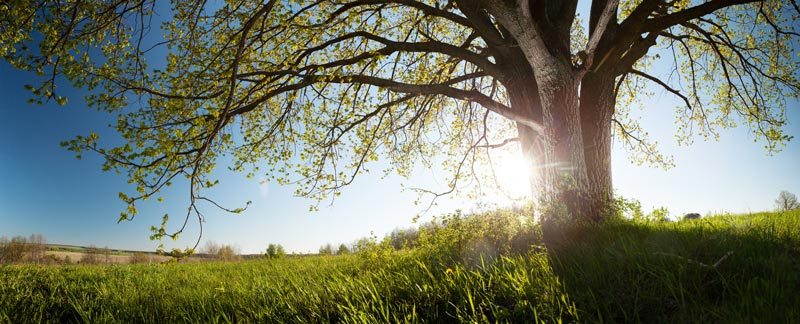Protecting Trees from the Sun
It may seem counterintuitive, but sunlight can actually harm trees.
Just as you can get a sunburn, a tree can get Sunscald. However, where serious sunburn for us is usually a temporary issue, Sunscald for a tree can lead to permanent damage and even premature decline.
What is Sunscald?
Sunscald is what happens when a tree receives too much exposure to sunlight. Sunscald can affect any part of the tree, including bark, leaves, and even fruit. The worst situation is when a tree’s bark becomes scalded.
Depending on the severity of the scald, the bark can develop purely aesthetic defects or may become damaged to the point of exposing the inner tissue of the tree. At this point, a scald is obvious to the observer, usually appearing as a fissure with dead bark surrounding it.
If the fissure opens all the way to the cambium layer of the tree—the outermost layer of the tree’s tissue, responsible for bark production—it may be impossible for the tree to heal.
Sunscald mostly affects trees with thinner bark (which includes young trees)
What does Sunscald do to a Tree?
What’s far worse than the aesthetic damage caused to the tree is the threat to the tree’s wellbeing.
A Sunscald in and of itself isn’t that detrimental to the tree—it’s what can happen to the tree once the scald is bad enough.
At the point that a sunscald fissure has reached the inner tissue, the tree has lost most of its protection against organisms that can cause infection and decay. Insects, bacteria, and fungi all have easy access to the tree and can begin to cause irreversible damage or even death.
How Can You Prevent Sunscald?
There are two very effective things to do to protect your tree from sunscald: block or reflect sunlight and avoid over-pruning.
Assuming the tree is the correct species for the climate and it’s been planted correctly, these two things can be a huge help toward preventing sunscald.
Blocking sunlight can be accomplished in a few ways, including cloth wraps (or other materials) or white paint. The paint is permanent, so isn’t usually used unless you’re planting an orchard. Depending on the species, protection may be seasonal or until the tree reaches a certain age.
Over-pruning can be a serious issue that exposes too much of a tree to sunlight for too much of the day. A certified arborist can correctly prune a tree for the season, the climate, and its positioning on your property. If you’re unsure how to prune your tree, please call a certified arborist—it isn’t worth risking the life of your tree!


